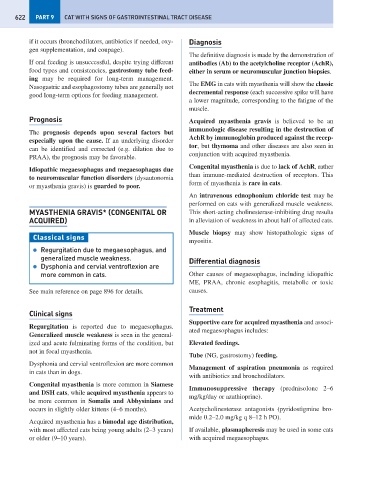Page 630 - Problem-Based Feline Medicine
P. 630
622 PART 9 CAT WITH SIGNS OF GASTROINTESTINAL TRACT DISEASE
if it occurs (bronchodilators, antibiotics if needed, oxy- Diagnosis
gen supplementation, and coupage).
The definitive diagnosis is made by the demonstration of
If oral feeding is unsuccessful, despite trying different antibodies (Ab) to the acetylcholine receptor (AchR),
food types and consistencies, gastrostomy tube feed- either in serum or neuromuscular junction biopsies.
ing may be required for long-term management.
The EMG in cats with myasthenia will show the classic
Nasogastric and esophagostomy tubes are generally not
decremental response (each successive spike will have
good long-term options for feeding management.
a lower magnitude, corresponding to the fatigue of the
muscle.
Prognosis Acquired myasthenia gravis is believed to be an
immunologic disease resulting in the destruction of
The prognosis depends upon several factors but
AchR by immunoglobin produced against the recep-
especially upon the cause. If an underlying disorder
tor, but thymoma and other diseases are also seen in
can be identified and corrected (e.g. dilation due to
conjunction with acquired myasthenia.
PRAA), the prognosis may be favorable.
Congenital myasthenia is due to lack of AchR, rather
Idiopathic megaesophagus and megaesophagus due
than immune-mediated destruction of receptors. This
to neuromuscular function disorders (dysautonomia
form of myasthenia is rare in cats.
or myasthenia gravis) is guarded to poor.
An intravenous ednophonium chloride test may be
performed on cats with generalized muscle weakness.
MYASTHENIA GRAVIS* (CONGENITAL OR This short-acting cholinesterase-inhibiting drug results
ACQUIRED) in alleviation of weakness in about half of affected cats.
Muscle biopsy may show histopathologic signs of
Classical signs
myositis.
● Regurgitation due to megaesophagus, and
generalized muscle weakness. Differential diagnosis
● Dysphonia and cervial ventroflexion are
more common in cats. Other causes of megaesophagus, including idiopathic
ME, PRAA, chronic esophagitis, metabolic or toxic
See main reference on page 896 for details. causes.
Treatment
Clinical signs
Supportive care for acquired myasthenia and associ-
Regurgitation is reported due to megaesophagus.
ated megaesophagus includes:
Generalized muscle weakness is seen in the general-
ized and acute fulminating forms of the condition, but Elevated feedings.
not in focal myasthenia.
Tube (NG, gastrostomy) feeding.
Dysphonia and cervial ventroflexion are more common
Management of aspiration pneumonia as required
in cats than in dogs.
with antibiotics and bronchodilators.
Congenital myasthenia is more common in Siamese
Immunosuppressive therapy (prednisolone 2–6
and DSH cats, while acquired myasthenia appears to
mg/kg/day or azathioprine).
be more common in Somalis and Abbysinians and
occurs in slightly older kittens (4–6 months). Acetycholinesterase antagonists (pyridostigmine bro-
mide 0.2–2.0 mg/kg q 8–12 h PO).
Acquired myasthenia has a bimodal age distribution,
with most affected cats being young adults (2–3 years) If available, plasmapheresis may be used in some cats
or older (9–10 years). with acquired megaesophagus.

